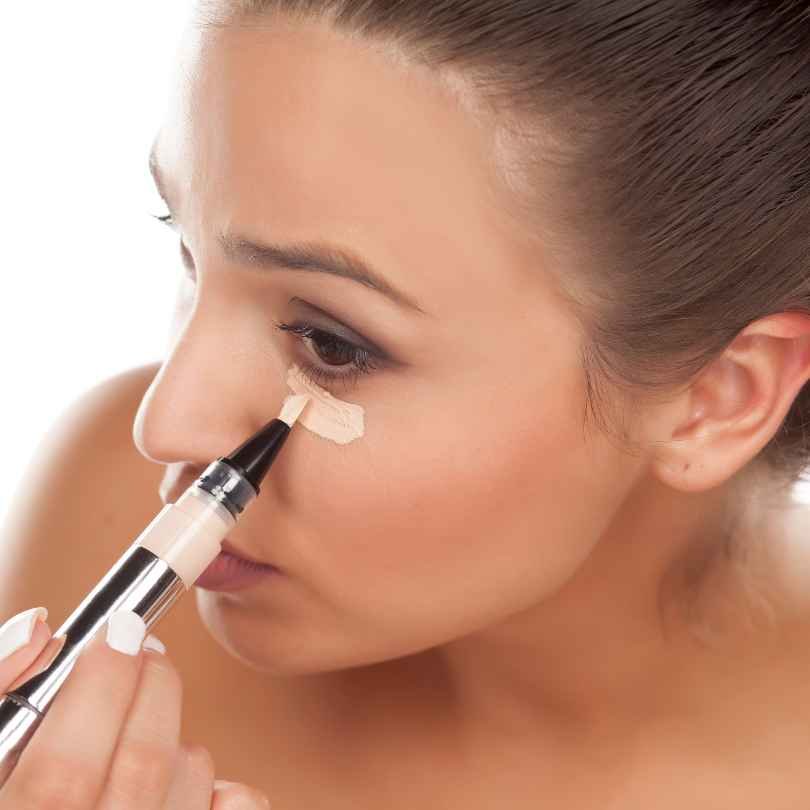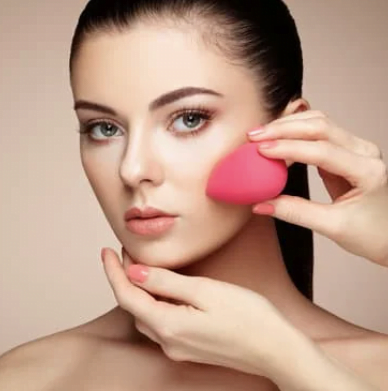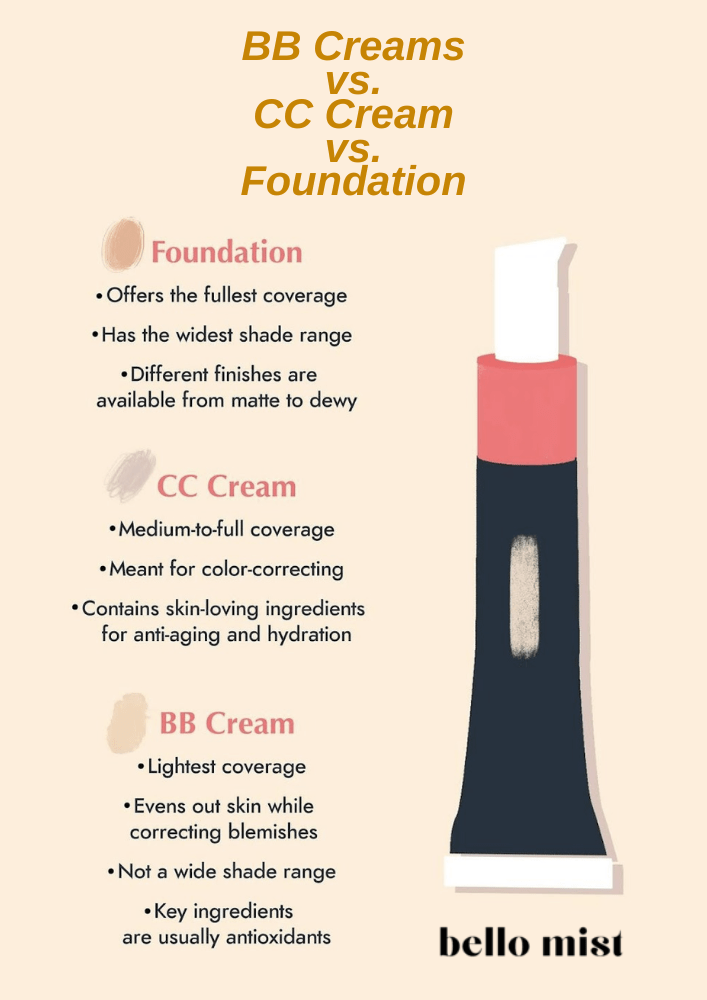If you are wondering what’s the difference between foundation vs concealer, two essential beauty products that makeup artists can’t live without; You have come to the right place.
Ever get lost in social media, in awe of the fantastic makeup looks you see? Many influencers share their go-to facial, eye, and lips techniques but rarely touch on the ongoing argument of foundation vs concealer.
People have their favorites and might not bother to explain their reasoning, but it’s helpful to understand the difference between the two and the benefits of each.
Here, we’ll cover everything you need to be aware of when it comes to concealers and foundations and provide examples of how to apply them correctly.
Foundation vs Concealer: What’s the difference?

You might be using foundation and concealer as part of your daily beauty routine, but do you know the differences between foundation vs concealer?
Both products help create a flawless complexion, reducing the visibility of wrinkles and blemishes, but each has its job to do. You can use either of them separately, but for the best results, it’s better to combine the two.
Concealer helps to conceal blemishes and dark circles, while the foundation is intended to even out the skin tone over the entire face. The significant distinction between the two is in their formula.
As you may have guessed, concealers are created to conceal dark circles and other issues and thus come in a much smaller container than foundation as they are not supposed to cover the entirety of the face. Not only are concealers more colorful than foundation, but they also have a much thicker texture.
Okay, now that you understand the main distinction between concealer and foundation, let’s delve deeper into foundation vs concealer.
Although you can use both products to conceal irregularities or other skin flaws, they can’t replace each other.
For example, if someone has hyperpigmentation in some areas of their face, it is best to apply a light coverage foundation to even out the skin tone and then use a concealer to hide the dark spots that the foundation could not cover.
This technique will give the skin a natural look and reduce the need for many concealers. Now that you know the difference between foundation vs concealer, let’s understand each in detail.
Foundation 101

When learning the difference between foundation vs concealer, it is necessary to know all about the foundation.
Foundation is a must-have for any makeup routine, serving as a base for the rest of the look. It helps to even out the complexion, covering any blemishes, dark spots, discoloration, or redness. This allows the other products to blend seamlessly into the skin, creating a natural result.
Numerous foundation shades are available, making it easy to find one that fits your skin tone precisely. You can do a few tests to identify your ideal shade. Select a foundation with the same shade and tint as your complexion to sport a natural look.
Foundations also come with various levels of coverage. You can opt for sheer, medium, or full range, depending on your needs. Sheer coverage foundations offer a subtle, natural look and make it easy to achieve a casual makeup look.
On the other hand, full-coverage foundations are more opaque, concealing any discoloration and creating a flawless visage. Moreover, each foundation has a distinct finish, such as satin, velvet, matte, or dewy, suitable for different skin types.
Various foundation formulas are available, so it’s easy to find the right one. In foundation vs concealer, let’s understand the different foundation types now.

Liquid foundations: Liquid foundations are the go-to for many makeup fans, with silicone-based formulas being the most popular. However, there are also water-based alternatives available.
You can get light, medium, or full coverage depending on your preference. And applying it is simple; use a makeup sponge, brush, or fingers to blend it into your skin.
Shop Liquid Foundation Now.
Powder foundations: If you’re looking for a lightweight foundation, consider opting for a pressed or a loose powder foundation. These have excellent oil-control properties, which makes them an ideal choice if you have oily skin.
Additionally, certain powders have a silky texture that can give you a gorgeous, natural, and minimalistic makeup look.
Shop Powder Foundation Now.
Cream foundations: Cream foundations are a great option if you need fuller coverage to conceal blemishes, breakouts, and discoloration. The formula is thicker than liquids and powders and tends to be more pigmented.
The main difference between cream and powder foundations is the texture and the amount of coverage they provide.
Stick foundations: Stick foundations are incredibly convenient; they come in a small tube that can easily fit in a purse or pocket. With a rich, creamy consistency, this type of foundation offers complete coverage for the skin.
BB cream: BB cream is the shortened version of ‘beauty balm’ and serves as a light foundation that provides skincare benefits like sun protection. It’s much lighter than a typical foundation but heavier than a moisturizer with a tint.
Shop BB Cream Now.
CC cream: If you’re looking for something to improve skin tone and reduce redness, try CC cream. ‘CC’ stands for ‘color correcting,’ and this type of cream can serve as an excellent primer for correcting any color discrepancies on the skin.
Shop CC Cream Now.
Concealer 101

When learning the difference between foundation vs concealer, it is necessary to know all about concealer.
If you find yourself dealing with any blemishes or discolorations, you can use concealer to conceal them. It’s made for use in certain areas and will mask imperfections your foundation can’t cover.
However, it’s essential to remember about foundation vs concealer that you cannot use concealer to cover the whole face.
You can apply it under your eyes to hide dark circles or on top of any discoloration or spots. Try using a concealer one shade lighter than your skin tone to get a brightening effect.
Another concealer type is a color corrector, used to balance skin discoloration. Generally, a color corrector is a unique tone that can neutralize the color of what you place it over.
In foundation vs concealer, let’s understand the various types of color correctors now.

- Green: hides redness and rosacea.
- Purple: neutralizes yellow undertones.
- Yellow: hides dark circles and brightens light and dark skin tones.
- Pink: hides dark circles and brightens fair skin tones.
- Peach: neutralizes dark circles and gray spots.
Like foundations, concealers come in several different formula types:

- Liquid: Liquid concealer is generally housed in a tube and is dispensed either via squeezing or with a doe foot applicator.
- Cream: Cream concealers are a little thicker than liquid concealers. They’re usually packaged in tubes and need a small makeup brush for application.
- Stick: A stick concealer looks identical to a lipstick bullet and has a creamy texture. You can apply it directly to the targeted area, then blend it with a brush or clean finger.
When deciding on the right concealer color, ensure it matches your skin’s tone or is a bit lighter. Using a shade that is too light can make your concealer look chalky, and if you don’t pick the right undertone, it can come off as orange.

Do you apply concealer or foundation first?
In foundation vs concealer, it can be challenging to figure out if you should put on concealer or foundation, as there isn’t a wrong answer.
Usually, the foundation should be the first step, but there may be cases where that isn’t the best option depending on your skin and the products you’re using. Ultimately, it’s your call – it depends on what sort of look you are going for.
For instance, if you use a concealer three shades lighter than your skin tone to emphasize specific areas, you should apply it after the foundation.
On the other hand, when trying to hide blemishes or color-correct, you should do all that before putting the foundation on.
The Pros & Cons when applying concealer first
Foundation vs concealer: What are the pros and cons of using concealer before foundation?

If you use a liquid foundation after applying concealer, it cannot be easy to ensure the concealer won’t shift away from the area it was first applied.
This difficulty in achieving a smooth finish can also affect your skin tone, as some concealers have color-correcting components that you should not spread across the face.
However, applying concealer beforehand is the best way to blend and achieve a more seamless look when using a powder foundation.
If you stay up too late and have major dark circles, you can use a color-correcting concealer first to help the situation. Gently press it into your skin and blend the edges with your foundation. You can apply another layer of concealer for further coverage.
You can use your concealer as a base if you need more foundation. Mix it with a moisturizer or serum to make it less thick.
The Pros & Cons when applying foundation first
Foundation vs concealer: What are the pros and cons of using foundation before concealer?

Typically, starting with a foundation is wise- especially if you’re using a cream-based one, BB cream, or CC cream. Foundations help even out complexion and disguise blemishes, so applying it as your base layer is essential.
That way, you’ll be able to tell precisely where you need concealer and how much of it to use. Focus on spots you want to hide, lighten, or brighten, such as under the eyes, on pimples, and around your nostrils.
Otherwise, you could be wasting product by applying too much and disrupting your skin tone when you blend a color-correcting concealer across your face.
When attempting to cover any marks, it’s best to always begin with your foundation and then move on to the concealer. If you start with the concealer, there’s an increased chance that it will settle into the skin, and the blemish will still be visible.
Put on the foundation as a first layer, cover the spot, and blend in where more coverage is needed. Then, finish up with a setting powder for everything to stay in place.
The only exception to this order is when you are not using a liquid foundation. If you use a powder or cream-based formula, it’s best to go in with the concealer first.

Foundation vs concealer vs bb cream
Let us understand the difference between foundation vs concealer vs primer now.
Foundations are the bedrock of makeup, offering a means to mask your skin’s natural complexion. They do not have any hydrating effects or bring about any skincare perks; instead, they can provide sheer to full coverage to diminish the look of spots and even out the skin’s color, forming an even base for other makeup items like blush or bronzer.
Concealer is designed to hide imperfections, such as redness and dark circles under the eyes, while BB creams have a lighter formula than foundation and offer sheer coverage.
Additionally, BB creams may contain skincare benefits, like sunscreen protection. The significant distinction between concealer and BB cream is their coverage level.
Tip: If you don’t have any blemishes or discolorations on your skin, you can put on bronzer for an organic look without having to use foundation. Blush also looks great without any base.

Foundation vs concealer vs primer
Let us understand the difference between foundation vs concealer vs primer now.
It is essential to prep your skin for makeup application. Before you apply sunscreen or any other makeup product, you should use a primer. Whether or not you require a primer depends on your skin type and the effect you want.
If your skin is oilier, select a primer with shine-control properties to keep your complexion matte throughout the day. For mature skin, you may choose a smoothing primer to blur out fine lines and wrinkles.
Generally, primers create a barrier between your skin and makeup, helping the foundation go on smoother. Primers and concealers are different formulas; primers are typically light and transparent, while concealers have a thicker consistency.

Final Verdict: Foundation vs Concealer
It’s commonly thought that foundation is the go-to when applying makeup, mainly if you use liquids. But the truth is your skin tone, the effect you’re trying to create, and the products you’re using all factor into your routine.
Our complexions are all unique, so feel free to tweak your approach to what works best with yours. So, foundation vs concealer: what to apply first?
A perfect makeup look starts with a good foundation and a concealer to hide imperfections or skin discoloration.
Applying a foundation first is recommended if you have a lot of redness or uneven skin tone, and then you can use concealer to spot-treat any blemishes that need more coverage.
Nevertheless, if you don’t have any redness and need to cover dark circles, you can go with a concealer with good coverage. In any case, for flawless makeup, both foundation and concealer are essential.
Hopefully, now you know the difference between foundation vs concealer and when to use each.
Read More
11 Best Brazilian Bum Bum Cream Dupes In 2023
12 Affordable Dior Lip Glow Dupes (2023)
11 Natural Shampoo Alternatives You Can Make At Home.
Is CeraVe Good For Oily Skin? An In-Depth Guide.
